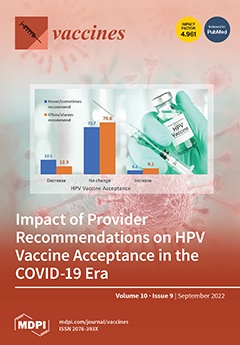Background: Patients with end-stage kidney disease undergoing hemodialysis are particularly vulnerable to severe COVID-19 as a result of older age and multimorbidities.
Objectives: Data are still limited and there are no published data on mortality in hemodialyzed patients in Poland, in particular when
[...] Read more.
Background: Patients with end-stage kidney disease undergoing hemodialysis are particularly vulnerable to severe COVID-19 as a result of older age and multimorbidities.
Objectives: Data are still limited and there are no published data on mortality in hemodialyzed patients in Poland, in particular when vaccines became available. We assessed the epidemiologic and clinical data of patients with laboratory-confirmed COVID-19 and assessed the mortality in 2019, 2020, and 2021, as well as the vaccination rate in 2021.
Patients and Methods: Retrospectively collected data from 73 Fresenius Nephrocare Poland hemodialysis centers and one public unit were analyzed.
Results: In 2021, the vaccination rate was 96%. The unadjusted mortality (number of deaths divided by number of patients) in 2019 was 18.8%, while the unadjusted (after exclusion of COVID-related deaths) mortality in 2020 was 20.8%, and mortality in 2021 was 16.22%. The prevalence of cardiovascular deaths in 2019 and 2020 was almost identical (41.4% vs. 41.2%, respectively), and in 2021, the figures increased slightly to 44.1%. The prevalence of sudden cardiac deaths in 2019 was higher than in 2020 (19.6% vs. 17.3%, respectively) and consequently decreased in 2021 (10.0%), as well as strokes (6.2% vs. 5.4%, and 3.31% in 2021), whereas deaths due to gastrointestinal tract diseases were lower (2.5% vs. 3.2%, and 2.25% in 2021), diabetes complications (0.5% vs. 1.3%, and 0.5% in 2021), sepsis (5.1% vs. 6.3%, and 8.79% in 2021), respiratory failure (1.2 vs. 1.6%, and 2.83% in 2021), and pneumonia (1.4% vs. 2.0%, and 0.82%). There were 1493 hemodialyzed COVID-19 positive patients, and among them, 191 died in 2020 (12.79%). In 2021, there were 1224 COVID-19 positive patients and 260 died (21.24%). The mortality of COVID-19 positive dialyzed patients contributed 13.39% in 2020 and 16.21% in 2021 of all recorded deaths.
Conclusions: The mortality among HD patients was higher in 2021 than in 2020 and 2019, despite the very high vaccination rate of up to 96%. The higher non-COVID-19 mortality may be due to the limited possibility of hospitalization and dedicated care during the pandemic. This information is extremely important in order to develop methods to protect this highly vulnerable patient group. Prevention plays a key role; other measures are essential in the mitigation and spread of COVID-19 in HD centers.
Full article






